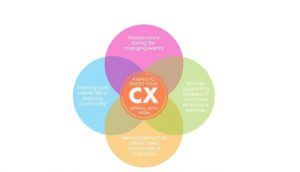In today’s fiercely competitive market landscape, businesses are constantly seeking ways to stand out, retain customers, and drive growth. One of the most effective strategies for achieving these goals is through the implementation of robust customer experience programs. These programs are meticulously designed to enhance every touchpoint a customer has with a brand, thereby fostering loyalty, advocacy, and long-term success.

What are customer experience programs?
Customer experience programs encompass a series of strategies, initiatives, and processes aimed at delivering exceptional experiences to customers at every stage of their interaction with a brand. These programs go beyond mere transactions, focusing on building meaningful relationships and creating positive emotions that drive customer satisfaction and loyalty.
As Walt Disney famously said, “Do what you do so well that they will want to see it again and bring their friends.” This encapsulates the essence of customer experience programs – exceeding expectations to leave a lasting impression that compels customers to return and spread the word.

What are the 4 types of customer experience?
- Digital Experience:
In an increasingly digital world, the digital experience plays a crucial role in shaping customer perceptions. This includes interactions on websites, mobile apps, social media platforms, and other digital channels. - In-Person Experience:
Despite the rise of digitalization, in-person experiences remain invaluable. Whether it’s a visit to a retail store, a restaurant, or a service center, the ambiance, interactions with staff, and overall atmosphere greatly influence customer satisfaction. - Phone Experience:
For many businesses, the phone remains a primary touchpoint for customer communication. A seamless phone experience, characterized by prompt, helpful service, can significantly enhance overall satisfaction. - Post-Purchase Experience:
The journey doesn’t end at the point of purchase. The post-purchase experience, including delivery, support, and follow-up, is equally vital in shaping perceptions and fostering loyalty.
As Jeff Bezos, the founder of Amazon, once said, “We see our customers as guests to a party, and we are the hosts. It’s our job every day to make every important aspect of the customer experience a little bit better.”
What are CX or EX programs?
CX (Customer Experience) and EX (Employee Experience) programs are intertwined facets of a successful business strategy. CX programs focus on enhancing interactions with customers, while EX programs concentrate on creating a positive work environment for employees. Research indicates a strong correlation between employee satisfaction and customer satisfaction, emphasizing the importance of prioritizing both aspects.
As Richard Branson, the founder of the Virgin Group, famously stated, “Clients do not come first. Employees come first. If you take care of your employees, they will take care of the clients.”

Customer experience programs examples
Numerous companies have set the benchmark for exceptional customer experience through their innovative programs. One such example is Starbucks, renowned for its personalized service and loyalty rewards program. By leveraging customer data and technology, Starbucks delivers tailored experiences that resonate with individual preferences, driving customer loyalty and advocacy.
Another notable example is Amazon, celebrated for its relentless focus on customer satisfaction. Amazon’s customer-centric approach, epitomized by its hassle-free return policy and expedited delivery services, has redefined standards for e-commerce experiences.
Best customer experience programs
Several organizations consistently rank among the best in customer experience due to their unwavering commitment to excellence. Apple, recognized for its intuitive products and seamless customer service, exemplifies a brand that prioritizes the customer journey at every touchpoint.
Similarly, Zappos, an online shoe and clothing retailer, has garnered acclaim for its exceptional customer service culture. Zappos’ customer-centric philosophy, embodied by its legendary customer support team, has earned it a reputation as a paragon of customer experience excellence.

What is a customer journey map?
A customer journey map is a visual representation of the various stages and touchpoints that a customer encounters while interacting with a brand. By mapping out the customer journey, businesses gain valuable insights into the customer experience, enabling them to identify pain points, areas for improvement, and opportunities for innovation.
As Maya Angelou once said, “People will forget what you said, people will forget what you did, but people will never forget how you made them feel.” This sentiment underscores the significance of customer experience programs in fostering emotional connections that resonate with customers long after the interaction has concluded.
In conclusion, customer experience programs are indispensable tools for businesses seeking to differentiate themselves in a competitive marketplace. By prioritizing the customer journey, leveraging technology, and nurturing a customer-centric culture, organizations can forge meaningful connections that drive loyalty, advocacy, and sustainable growth. As the adage goes, “The customer experience is the next competitive battleground,” and those who prioritize it will undoubtedly emerge victorious in the ever-evolving landscape of business.